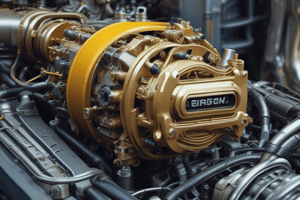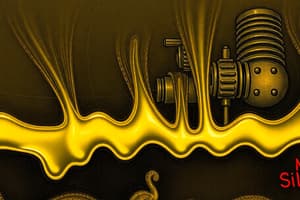Podcast
Questions and Answers
Match each lubrication system component with its primary function:
Match each lubrication system component with its primary function:
Oil Pan = Reservoir for engine oil. Oil Pump = Circulates oil throughout the engine under pressure. Oil Filter = Removes contaminants from the oil. Oil Pressure Relief Valve = Regulates oil pressure to prevent excessive buildup.
Match each type of lubrication system with its key characteristic:
Match each type of lubrication system with its key characteristic:
Wet Sump System = Oil is stored in the oil pan at the bottom of the engine. Dry Sump System = Oil is stored in a separate reservoir, scavenge pumps remove oil from the engine. Pre-oiling System = Circulates oil before engine start. Total Loss System = Oil is applied to parts and not recirculated (not in original text)
Match the lubrication system function to its purpose:
Match the lubrication system function to its purpose:
Minimizing Friction and Wear = Creating a thin film between moving surfaces. Cooling = Absorbing heat from engine components. Cleaning = Carrying away contaminants like dirt and metal particles. Sealing = Helping seal gaps between piston rings and cylinder walls.
Match the following components with their location in the lubrication system:
Match the following components with their location in the lubrication system:
Match the lubrication system component with the related engine part it protects:
Match the lubrication system component with the related engine part it protects:
Match each term with its corresponding description related to oil system maintenance:
Match each term with its corresponding description related to oil system maintenance:
Match the pump type to its general application in an oil lubrication system:
Match the pump type to its general application in an oil lubrication system:
Match the oil property with its effect on engine performance:
Match the oil property with its effect on engine performance:
Match the lubrication method with its corresponding description:
Match the lubrication method with its corresponding description:
Match these oil additives with their primary function:
Match these oil additives with their primary function:
Match each oil type to its general characteristics:
Match each oil type to its general characteristics:
Match each maintenance task with its benefit:
Match each maintenance task with its benefit:
Match the following oil properties to their definitions:
Match the following oil properties to their definitions:
Match each potential problem with its possible cause:
Match each potential problem with its possible cause:
Match the oil flow location with its purpose:
Match the oil flow location with its purpose:
Match the engine component with its lubrication need:
Match the engine component with its lubrication need:
Match the oil maintenance action with its frequency or timing:
Match the oil maintenance action with its frequency or timing:
Associate each oil related symptom with its impact on engine health:
Associate each oil related symptom with its impact on engine health:
Flashcards
Engine Lubrication System
Engine Lubrication System
Reduces friction, removes heat, carries away contaminants in an engine.
Lubrication: Friction Reduction
Lubrication: Friction Reduction
Minimizes direct contact between moving surfaces.
Lubrication: Cooling
Lubrication: Cooling
Absorbs and dissipates heat from engine components.
Lubrication: Cleaning
Lubrication: Cleaning
Signup and view all the flashcards
Oil Pan
Oil Pan
Signup and view all the flashcards
Oil Pump
Oil Pump
Signup and view all the flashcards
Oil Filter
Oil Filter
Signup and view all the flashcards
Dry Sump System
Dry Sump System
Signup and view all the flashcards
Total Loss System
Total Loss System
Signup and view all the flashcards
Pressure Feed Lubrication
Pressure Feed Lubrication
Signup and view all the flashcards
Splash Feed Lubrication
Splash Feed Lubrication
Signup and view all the flashcards
Combination Feed
Combination Feed
Signup and view all the flashcards
Mist/Spray Lubrication
Mist/Spray Lubrication
Signup and view all the flashcards
Viscosity
Viscosity
Signup and view all the flashcards
Viscosity Index
Viscosity Index
Signup and view all the flashcards
Oil Additives
Oil Additives
Signup and view all the flashcards
Mineral Oil
Mineral Oil
Signup and view all the flashcards
Synthetic Oil
Synthetic Oil
Signup and view all the flashcards
Study Notes
- Engine lubrication systems are vital for the operation and longevity of internal combustion engines
- They reduce friction between moving parts, remove heat, and carry away contaminants
Purpose of Lubrication Systems
- Lubrication systems minimize friction and wear by creating a thin film between moving surfaces which reduces direct contact
- They also cool engine components by absorbing heat which helps to regulate temperature
- Engine oil cleans by carrying away contaminants like dirt, metal particles, and combustion byproducts
- Oil helps seal the gaps between piston rings and cylinder walls, improving compression
- Oil forms a protective layer on metal surfaces, preventing corrosion
Components of a Typical Lubrication System
- Oil Pan: The reservoir for the engine oil, typically located at the bottom of the engine
- Often includes baffles to prevent oil starvation during vehicle movement
- Oil Pump: Circulates oil throughout the engine under pressure
- Usually a positive displacement pump (gear or rotor type) driven by the engine
- Oil Filter: Removes contaminants from the oil to keep it clean
- Types include full-flow and bypass filters
- Oil Pressure Relief Valve: Regulates oil pressure to prevent excessive pressure buildup
- Typically spring-loaded and opens to bypass oil back to the oil pan when pressure exceeds a set limit
- Oil Cooler: Cools the oil, which is especially important in high-performance or heavy-duty applications
- Can be air-cooled or liquid-cooled
- Oil Passages/Galleries: Internal channels within the engine block and cylinder head that distribute oil to various components
- Oil Control Rings: Located on the pistons to scrape excess oil off the cylinder walls and return it to the oil pan
- Oil Pressure Sensor/Switch: Monitors oil pressure and provides a signal to the engine control unit (ECU) or a warning light on the dashboard
Types of Lubrication Systems
- Wet Sump System: The most common type, where the oil is stored in the oil pan at the bottom of the engine
- Simple and cost-effective
- Can be prone to oil starvation in high-performance applications with extreme G-forces
- Dry Sump System: The oil is stored in a separate reservoir, and one or more scavenge pumps remove oil from the engine and return it to the reservoir
- More complex and expensive than wet sump systems
- Eliminates oil starvation issues and allows for a lower engine mounting position
- Commonly used in racing and high-performance engines
- Pre-oiling System: Circulates oil before engine start
- Improves the longevity of the engine
- Total Loss System: Oil is injected into the engine and is burnt along with the fuel
- Primarily used by simple two-stroke engines
Lubrication Methods
- Pressure Feed: Oil is supplied under pressure to critical components like main bearings, connecting rod bearings, and camshaft bearings
- Ensures adequate lubrication even under high loads and speeds
- Splash Feed: Moving parts like the crankshaft splash through the oil in the oil pan, distributing it to other components
- Simple but less effective than pressure feed
- Often used in combination with pressure feed to lubricate less critical parts
- Combination Feed: Uses both pressure feed and splash feed methods
- Mist/Spray Lubrication: Oil is atomized and sprayed onto components
- Common in two-stroke engines where oil is mixed with fuel
Oil Flow Path in a Typical Wet Sump System
- Oil is drawn from the oil pan by the oil pump
- The oil pump sends the oil through the oil filter to remove contaminants
- Filtered oil flows through the main oil gallery
- Oil is distributed from the main gallery to the main bearings, connecting rod bearings, camshaft bearings, and other components
- Oil also lubricates the cylinder walls and valve train
- Oil drains back to the oil pan via gravity
Oil Properties and Types
- Viscosity: A measure of a fluid's resistance to flow
- Higher viscosity oils are thicker and provide better protection at high temperatures and loads
- Lower viscosity oils flow more easily and improve fuel efficiency
- Viscosity Index: Indicates how much an oil's viscosity changes with temperature
- Higher viscosity index oils maintain their viscosity better over a wide temperature range
- Additives: Chemicals added to oil to improve its properties
- Detergents: Help keep engine parts clean by preventing the formation of deposits
- Dispersants: Suspend contaminants in the oil to prevent them from clumping together
- Anti-wear Agents: Reduce wear by forming a protective layer on metal surfaces
- Corrosion Inhibitors: Protect metal surfaces from corrosion
- Viscosity Index Improvers: Reduce the change in viscosity with temperature
- Friction Modifiers: Reduce friction and improve fuel efficiency
- Types of Oil:
- Mineral Oil: Refined from crude oil
- Least expensive but may not provide the same level of protection as synthetic oils
- Synthetic Oil: Chemically synthesized
- Offer better protection, higher viscosity index, and longer service life compared to mineral oils
- Semi-Synthetic Oil (Synthetic Blend): A mixture of mineral and synthetic oils
- Offers a compromise between cost and performance
- High-Mileage Oil: Formulated for older engines with higher mileage
- Contains additives to help reduce oil consumption and seal leaks
- Mineral Oil: Refined from crude oil
Maintenance of Lubrication Systems
- Regular Oil Changes: Replacing the oil and oil filter at recommended intervals
- Prevents the buildup of contaminants and ensures proper lubrication
- Checking Oil Level: Regularly checking the oil level and adding oil as needed
- Prevents oil starvation and engine damage
- Oil Filter Replacement: Replacing the oil filter with each oil change
- Ensures that contaminants are effectively removed from the oil
- Inspecting for Leaks: Checking for oil leaks and repairing them promptly
- Prevents oil loss and potential engine damage
- Using the Correct Oil Type: Using the oil type and viscosity recommended by the manufacturer
- Ensures optimal performance and protection
Common Problems and Troubleshooting
- Low Oil Pressure: Can be caused by low oil level, worn oil pump, clogged oil filter, or internal engine damage
- High Oil Consumption: Can be caused by worn piston rings, valve stem seals, or oil leaks
- Oil Leaks: Can occur at various points in the system, such as seals, gaskets, or oil lines
- Oil Contamination: Can be caused by coolant leaks, fuel leaks, or excessive blow-by
- Sludge Buildup: Can be caused by infrequent oil changes or using low-quality oil
- Overheating: Excessive heat can cause oil to break down and lose its lubricating properties, potentially leading to engine damage
Studying That Suits You
Use AI to generate personalized quizzes and flashcards to suit your learning preferences.




